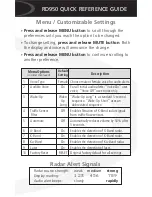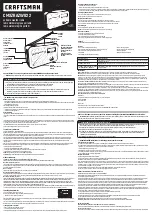
Compass safe distance
When choosing a suitable location for your product you should aim to maintain the maximum possible
distance between the product and any installed compass. This distance should be at least 1 m (3 ft) in
all directions. For smaller vessels it may not be possible to achieve this distance. In this situation
ensure that the compass is not affected by the product when it is powered on.
EMC installation guidelines
Raymarine® equipment and accessories conform to the appropriate Electromagnetic Compatibility
(EMC) regulations, to minimize electromagnetic interference between equipment and minimize the
effect such interference could have on the performance of your system
Correct installation is required to ensure that EMC performance is not compromised.
Note:
In areas of extreme EMC interference, some slight interference may be noticed. Where this occurs
the product and the source of the interference should be separated by a greater distance.
For
optimum
EMC performance we recommend that wherever possible:
• Raymarine® equipment and cables connected to it are:
– At least 1 m (3 ft) from any equipment transmitting or cables carrying radio signals e.g. VHF radios,
cables and antennas. In the case of SSB radios, the distance should be increased to 2 m (7 ft).
– More than 2 m (7 ft) from the path of a Radar beam. A Radar beam can normally be assumed to
spread 20 degrees above and below the radiating element.
• The product is supplied power from a separate battery from that used for engine start. This is
important to prevent erratic behavior and data loss which can occur if the engine start does not
have a separate battery.
• Only Raymarine® specified cables are used.
• Cables are not cut or extended, unless doing so is detailed in the installation instructions.
Note:
Where constraints on the installation prevent any of the above recommendations
, always ensure
the maximum possible separation between different items of electrical equipment, to provide the
best conditions for EMC performance throughout the installation.
Suppression ferrites
• Raymarine cables may be pre-fitted or supplied with suppression ferrites. These are important for
correct EMC performance. If ferrites are supplied separately to the cables (i.e. not pre-fitted), you
must fit the supplied ferrites, using the supplied instructions.
• If a ferrite has to be removed for any purpose (e.g. installation or maintenance), it must be replaced
in the original position before the product is used.
• Use only ferrites of the correct type, supplied by Raymarine or its authorized dealers.
• Where an installation requires multiple ferrites to be added to a cable, additional cable clips should
be used to prevent stress on the connectors due to the extra weight of the cable.
Connections to other equipment
Requirement for ferrites on non-Raymarine cables.
If your product is to be connected to other equipment using a cable not supplied by Raymarine, a
suppression ferrite MUST always be attached to the end of the cable nearest to the Raymarine
product.
Antenna mounting and EME exposure
Ensure that your VHF antenna is connected to the radio before transmission.
Raymarine® declares a Maximum Permissible Exposure (MPE) radius of 1.8 meters (5.9 ft.) for this
system, assuming 25 watts output to an omnidirectional antenna of 3dBi gain or less.
For watercraft with suitable structures, the antenna base must be at least 3.8 meters (12.5 ft) above
the main deck to meet the MPE for persons up to 2 metres (6.6 ft) tall. For watercraft without such
structures, the antenna must be mounted so that its base is a minimum of 1.8 meters (5.9 ft.) vertically
from heads of all persons.
31
















































